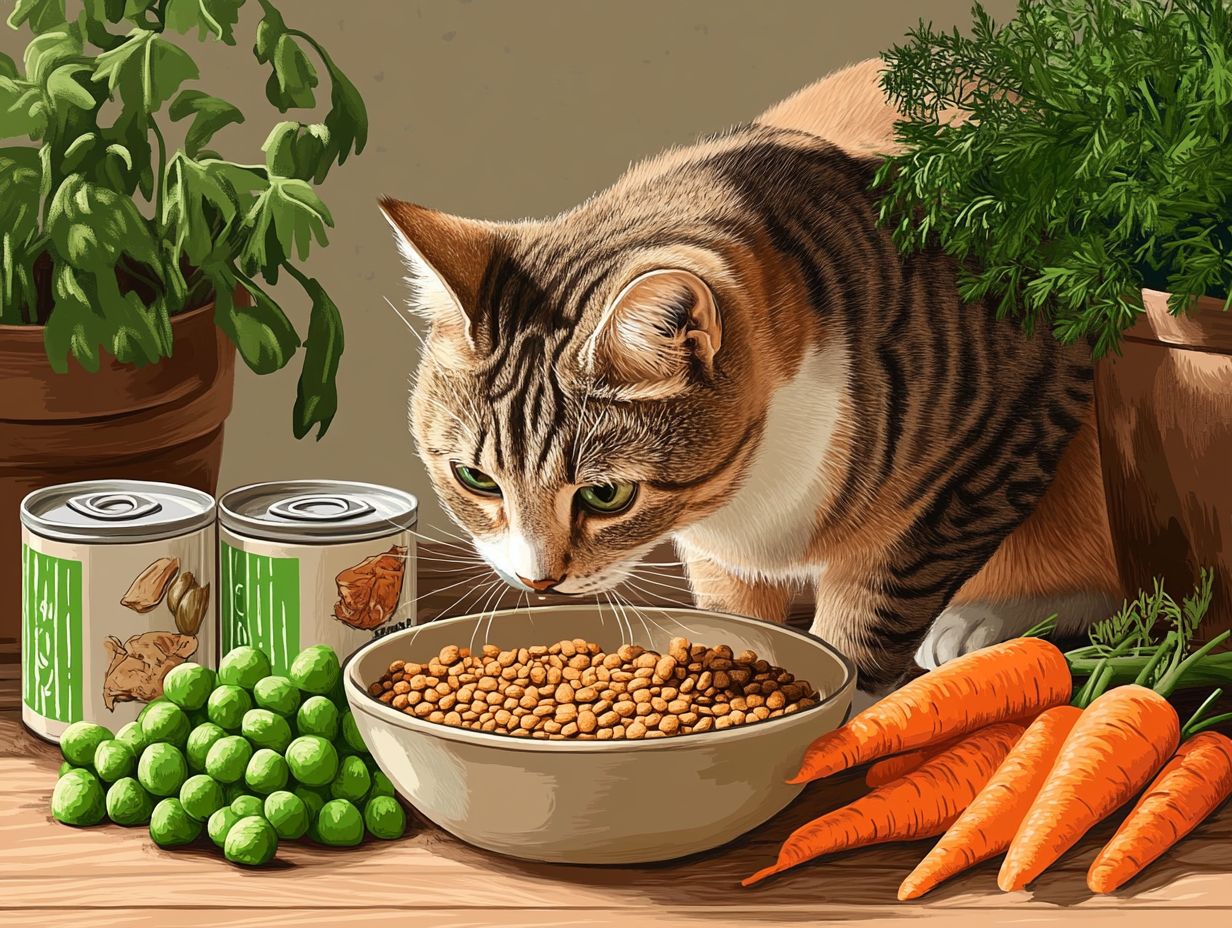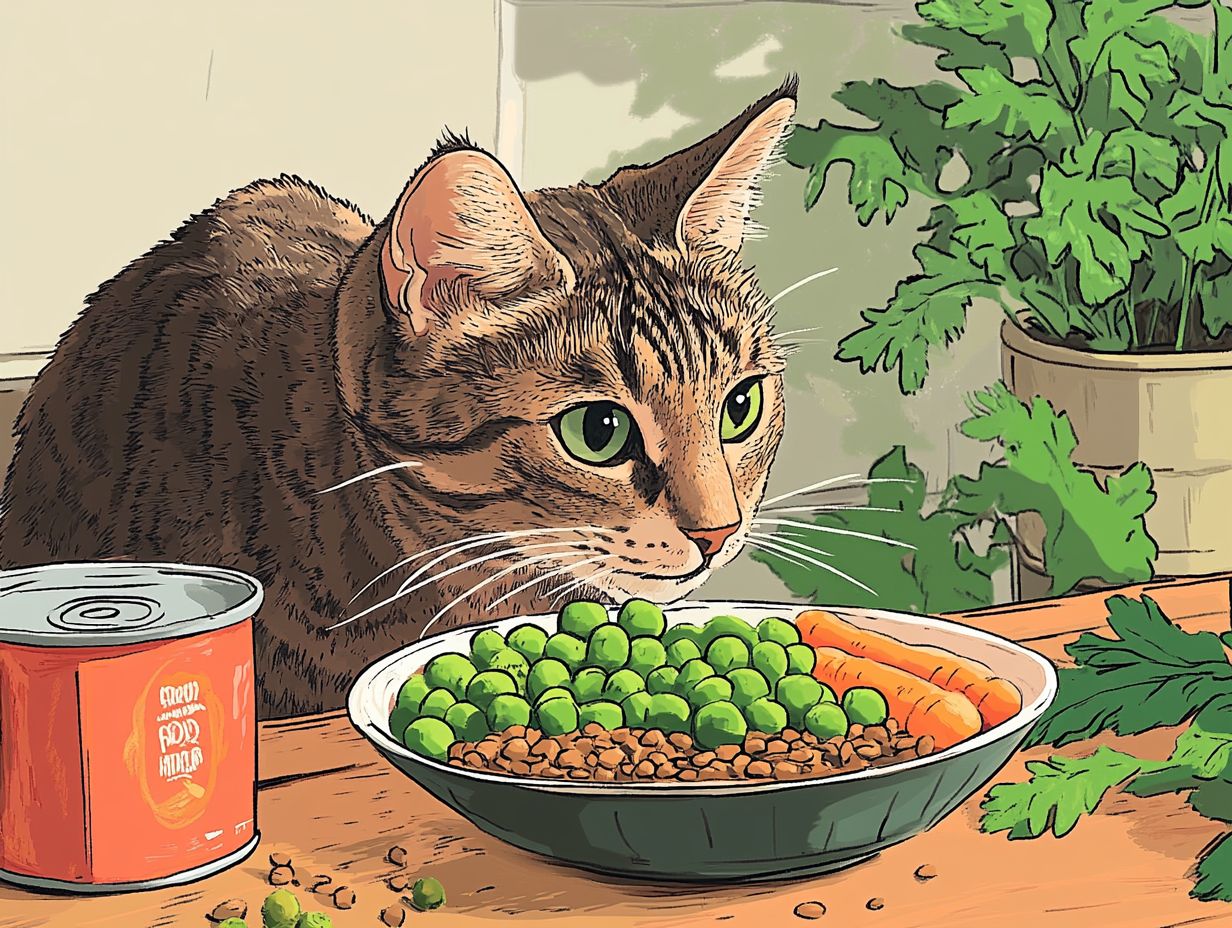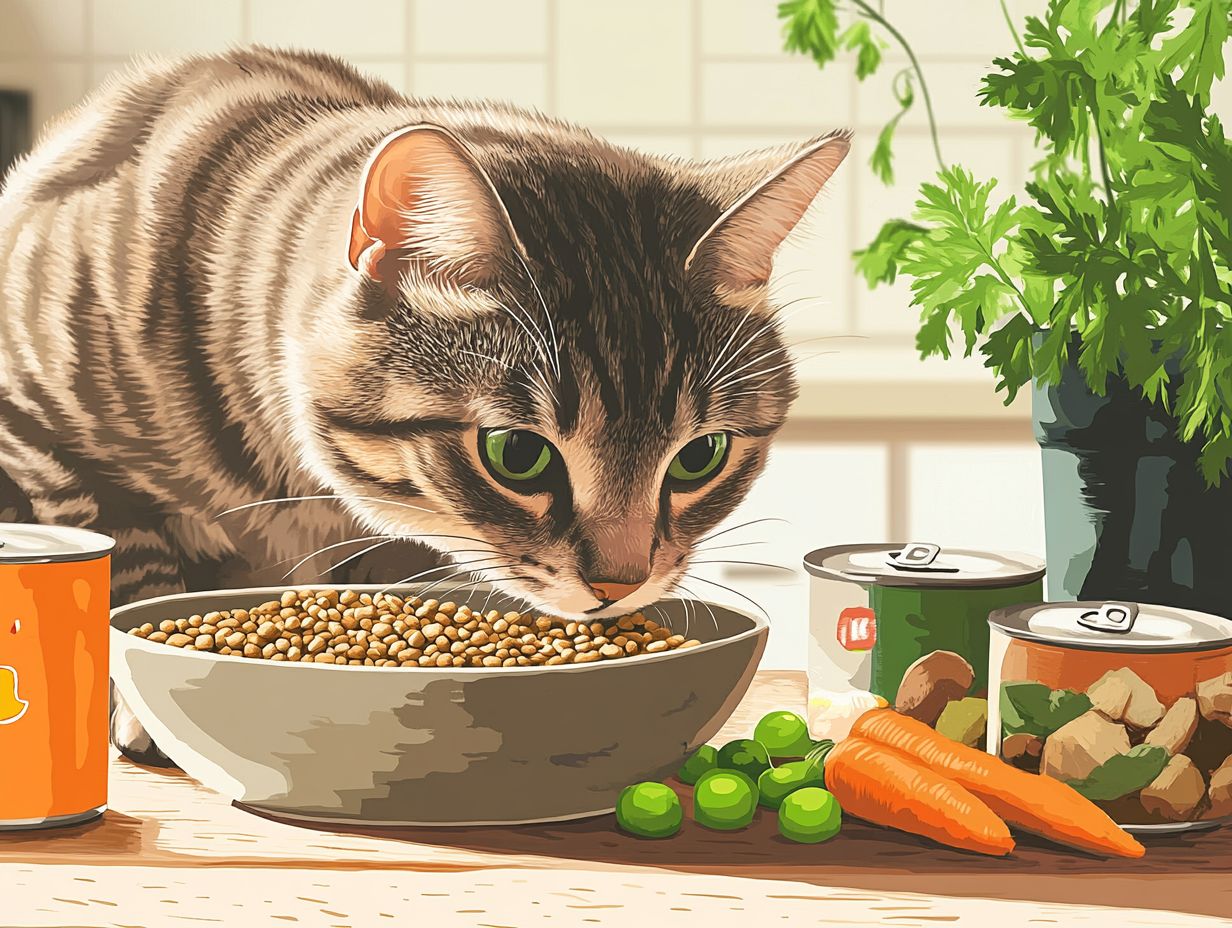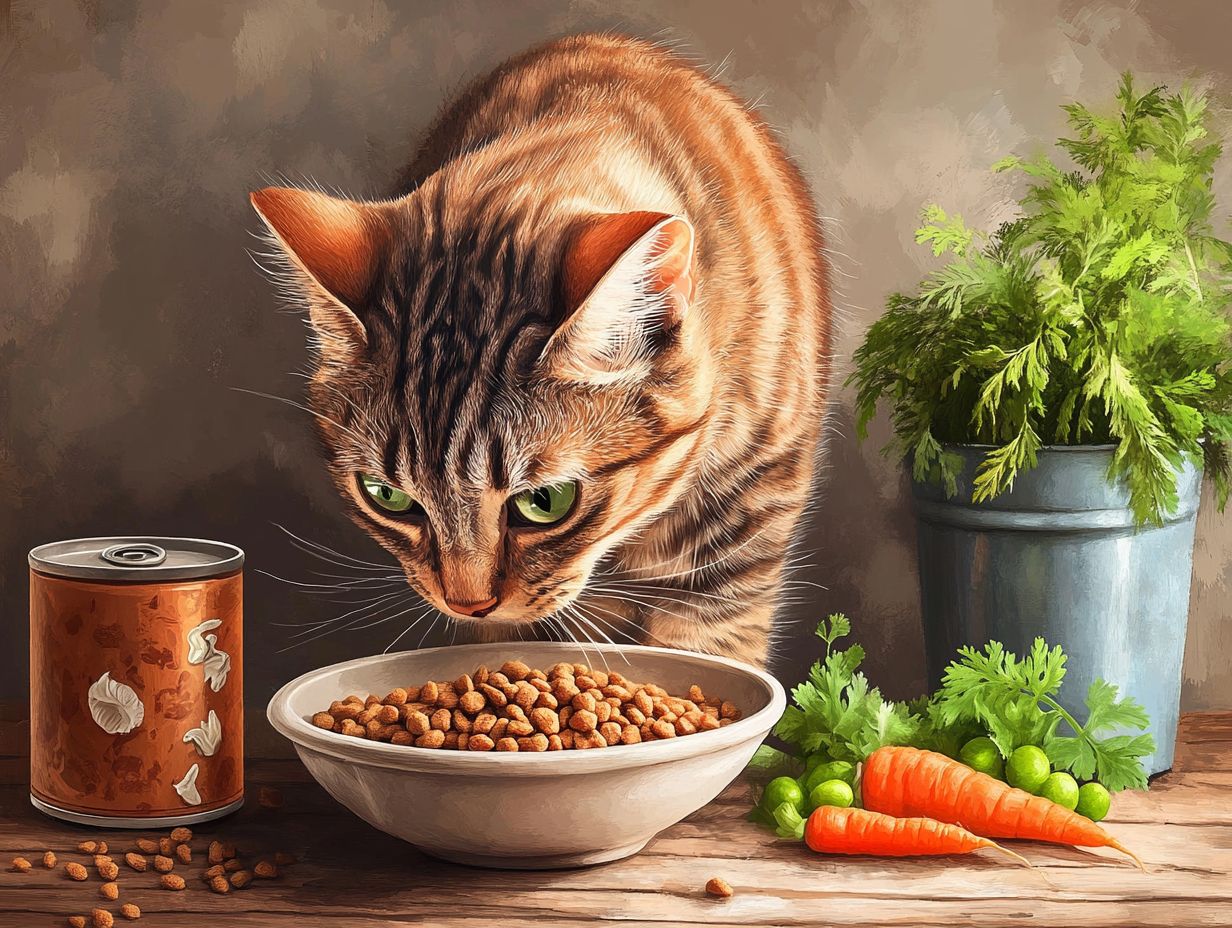Cat allergies can be puzzling for pet owners, often leading them to search for the right diet to manage food allergies and sensitivities that keep their cats healthy and comfortable.
This article explores common allergens in cats, the symptoms that indicate allergies, and the unexpected downsides of grain-free diets. We advise readers to consult a veterinarian for personalized dietary advice, especially when transitioning to new diets or managing allergies.
We introduce grain-inclusive options that might be better suited for allergic cats, provide tips for transitioning to a new diet, and share strategies for managing allergies effectively. Whether you’re a concerned pet parent or just curious about feline health, this guide aims to shed light on how to best support your allergic cat.
Key Takeaways:

- Consider grain-inclusive options for allergic cats as an alternative to grain-free diets.
- Choose grain-inclusive options that are free from common allergens to help reduce the risk of developing allergies while providing necessary nutrients.
- Transition your cat to a new diet slowly and monitor their reaction closely.
Understanding Cat Allergies
Understanding cat allergies is essential for cat owners, as these allergies can adversely affect a cat’s health and overall quality of life. Allergies in cats can manifest in various ways and are often caused by specific food sensitivities, such as grain allergies or reactions to certain natural ingredients in pet food.
Veterinarians commonly recommend holistic nutrition approaches to address these issues, ensuring that a cat’s natural needs and nutritional requirements are adequately met. While holistic diets can be beneficial, they should be carefully formulated to meet the nutritional requirements of obligate carnivores, promoting feline wellness and supporting proper digestive health.
What Are the Most Common Allergens for Cats?
The most common allergens for cats include grains, certain protein sources, and legumes. However, not all cats are allergic to grains, so it is crucial to focus on the individual cat’s specific allergies. These ingredients can lead to food allergies and dietary sensitivities that compromise a cat’s health and well-being.
The resulting allergens may cause a wide range of symptoms, including itching, gastrointestinal upset, and even behavioral changes, all of which can diminish the cat’s quality of life.
It is essential for cat owners to monitor their pets for allergies to common ingredients such as wheat, corn, and soy, as well as specific proteins like chicken and beef, which are frequently implicated in allergy cases.
Adopting holistic diets can serve as an effective alternative, offering limited-ingredient solutions, novel proteins, or grain-free formulations that support sensitive digestive systems. These dietary approaches not only alleviate allergy symptoms but also promote overall health by ensuring balanced nutrition tailored to the unique needs of sensitive cats.
What Are the Symptoms of Allergies in Cats?
Symptoms of allergies in cats can vary widely, including digestive issues, skin irritations, and behavioral changes. These symptoms are among the reasons pet owners seek the advice of veterinary professionals.
It is essential for pet owners to understand the differences in these symptoms, as they can help determine whether food allergies, environmental allergens, or more serious underlying health issues are involved. Some physical signs, such as excessive scratching, hair loss, or gastrointestinal symptoms like vomiting or diarrhea, may go unnoticed if pet owners are not attentive to their cat’s normal behavior.
Additionally, behavioral changes, such as increased anxiety or atypical aggression, may indicate that a cat is uncomfortable due to allergy-related symptoms. Early intervention in recognizing these symptoms is crucial for managing allergic responses and highlights the importance of veterinary professionals in diagnosing and finding the best treatment options for each individual cat. Severe or persistent symptoms warrant immediate veterinary care, as they may lead to life-threatening reactions like anaphylaxis.
Why Grain-Free May Not Be the Best Option for Allergic Cats
While grain-free diets are becoming increasingly popular among pet owners, they may not be the best option for allergic cats, as these diets can pose potential risks that adversely affect health outcomes. Recent research has revealed associations between grain-free diets and health issues, including heart disease such as dilated cardiomyopathy.
Many pet owners, swayed by marketing claims, mistakenly believe that simply eliminating grains will resolve their cats’ allergies. Veterinary nutritionists caution that grain-free diets can lead to imbalanced nutrient ratios by substituting grains with carbohydrate sources that may not sufficiently meet a cat’s high protein dietary needs.
It is important for pet owners to monitor food labels for allergens and adhere to AAFCO standards to ensure quality and safety in pet food manufacturing.
Additionally, practical advice on food storage and handling is essential for enhancing the safety of both homemade and commercial diets. Keeping food in a cool, dry place and checking for spoilage can help maintain their quality.
Adopting a nutritional approach tailored to obligate carnivores that takes into account the unique requirements of each individual cat is essential.
What Are the Potential Risks of Grain-Free Diets for Cats?

Grain-free diets for cats can pose potential risks, particularly regarding nutritional balance and dietary sensitivities that may arise from these dietary choices. While these diets are becoming increasingly popular among pet owners wishing to avoid grains, they can lead to long-term health issues if not properly balanced. Deficiencies may include essential nutrients such as taurine, certain vitamins, and fatty acids.
For instance, the absence of certain carbohydrates may result in deficiencies in essential nutrients, such as fiber and specific vitamins, which are crucial for the normal functioning of all body systems in cats. Additionally, since cats have evolved to have a varied diet, making sudden changes to their diet can disrupt their gut microflora. It is advisable to transition diets gradually to minimize gastrointestinal upset.
Therefore, alternatives such as high-quality grain-containing diets or well-formulated grain-free diets that meet complete nutritional requirements are vital for maintaining optimal nutrition. Always consult with a veterinarian before making any significant dietary changes to ensure compliance with current veterinary nutrition standards, including AAFCO and WSAVA guidelines.
Why Do Some Cats Develop Allergies to Grain-Free Foods?
Some cats may develop allergies to grain-free foods due to the introduction of new sources of protein, carbohydrates, or other ingredients that their gastrointestinal systems cannot tolerate. This highlights the complexity of feline diets. It is important to note that certain protein sources beyond grains can also elicit allergies in cats, necessitating a careful selection of balanced protein sources.
Navigating the various dietary options can be quite challenging for cat owners, as the ideal diet often varies significantly among individual cats. For some felines, substituting grains with ingredients like peas or potatoes may seem beneficial; however, these replacements can also trigger allergic reactions in certain cats.
It is essential to recognize that each cat’s body reacts differently to new foods. Therefore, monitoring a cat’s behavior and health after introducing a new diet is crucial, as adverse reactions may not manifest immediately. Tailoring a cat’s diet to its specific needs is vital for promoting optimal health and well-being.
Grain-Inclusive Options for Allergic Cats
Grain-inclusive options for allergic cats can offer the balanced nutrients essential for overall health and wellness, challenging the misconception that grains are inherently harmful to feline diets.
Many pet owners are realizing that a thoughtfully selected grain-inclusive diet can meet their cats’ natural needs while addressing dietary sensitivities. By working closely with veterinary professionals, cat owners can identify high-quality pet foods that incorporate beneficial grains and nutritional profiles tailored to their pets’ requirements.
This approach helps ensure that their dietary choices promote optimal digestive health and energy levels.
What Are Some Alternatives to Grain-Free Foods for Cats?
Some excellent substitutes for grain-free cat foods include high-quality grain-inclusive products that prioritize natural ingredients and overall wellness, while still ensuring nutritional adequacy.
Whole grains such as brown rice, barley, and oats can provide essential nutrients and are generally gentle on sensitive stomachs. Holistic diets that focus on specific dietary needs can offer tailored nutrition solutions for individual feline companions.
For example, a typical feeding regimen that includes lean proteins alongside wholesome grains can enhance overall health and vitality. Additionally, many brands offer specialized formulas designed for food sensitivities, allowing pet owners to choose products that meet their cats’ unique dietary requirements without compromising on quality.
What Are the Benefits of Choosing Grain-Inclusive Options for Allergic Cats?
Grain-inclusive options for allergic cats offer several advantages, including balanced nutrition and improved health outcomes. When whole grains are incorporated into their diets, they can enhance the nutritional balance and overall health of allergic cats.
These grain-inclusive choices contribute to better digestive health by providing fiber, which helps maintain a healthy gut, regulates the movement of food through the digestive system, and aids in preventing hairballs. Additionally, grain options support energy metabolism, allowing cats to stay active and playful.
It’s crucial to monitor specific life stages (kittens, pregnant/nursing cats, and senior cats) for unique dietary requirements, including any special considerations regarding grain inclusion. Practical feeding tips include proper food storage methods and how to identify spoilage, ensuring safety in feeding practices.
Veterinary professionals highlight that grain-inclusive diets can be tailored to meet the specific needs of allergic cats, ensuring they receive essential nutrients while avoiding allergens. However, it is crucial to understand that while some cats may tolerate grains, they are obligate carnivores and require high-quality animal proteins as the primary component of their diet. The inclusion of grains should not compromise the protein source, promoting a balanced source of calories, helping maintain a healthy weight, and fostering overall health, enabling cats to live their lives to the fullest without the discomfort of allergies.
How to Transition Your Cat to a Grain-Inclusive Diet

Transitioning your cat to a grain-inclusive diet requires careful planning and patience. It is essential to consult with veterinary professionals before making any dietary changes, especially for cats with allergies or specific health concerns. This ensures that your cat adapts to the new food at a suitable pace to safeguard their health and well-being.
The transition period involves gradually introducing the new diet, allowing your cat’s digestive system to adjust to the changes. During this time, you should closely monitor your cat’s response to the new food, paying particular attention to any changes in energy levels, health outcomes, and overall behavior. Careful monitoring is essential, as some cats may have sensitivities during the transition.
Consulting with veterinary professionals throughout this process can provide valuable guidance and reassurance.
What Are the Steps to Transitioning Your Cat to a New Diet?
Transitioning your cat to a new diet involves several critical steps aimed at minimizing digestive upset and ensuring overall wellness throughout the process.
- Begin with a gradual introduction of the new food over the course of a week or longer to help your cat adapt comfortably.
- Start by mixing a small amount of the new food with the current diet, gradually increasing the proportion of the new food while decreasing the old.
During this transition, be vigilant for any signs of distress in your cat, such as vomiting, diarrhea, or changes in appetite. If these symptoms persist or worsen, it may be necessary to seek advice from a medical professional for alternatives or guidance.
How to Monitor Your Cat’s Reaction to the New Diet?
Monitoring a cat’s response to a new diet is crucial for identifying potential issues and ensuring optimal health care outcomes. This involves closely observing various factors throughout the diet transition.
Energy levels are an important indicator; significant increases or decreases may suggest that the new food is either harmful or beneficial to the cat’s health. Additionally, digestive health should be monitored during this period. Any changes in the consistency or frequency of feces could indicate intolerance or allergies to the ingredients in the new food. Additionally, be aware of signs of nutritional deficiencies, such as a dull coat, lethargy, or weight loss, which may arise from an inappropriate diet.
Behavioral changes, such as alterations in mood, appetite, or activity level, should also be noted, as these are often the first signs of the cat’s reaction to the new diet. In any case, it is essential to consult veterinary professionals if any concerning signs arise, as they can provide guidance on necessary adjustments to achieve optimal nutritional balance.
Tips for Managing Allergies in Cats
Ensuring overall wellness and quality of life for cats with allergies goes beyond the medical aspects of diagnosis and treatment; it requires practical advice and support from veterinary professionals to achieve the best outcomes.
Cat owners should always be mindful of their cats’ individual needs and sensitivities, making choices that promote their digestive health and well-being while addressing their unique dietary requirements.
Creating a supportive environment for the cat and maintaining regular interactions with veterinary professionals will help ensure that allergy management is as effective as possible. While environmental management can support allergy management, it should not replace a nutritionally balanced diet tailored to the cat’s needs.
What Are Some Other Ways to Manage Allergies in Cats?
Along with d dietary modifications, there are several other methods for managing allergies in cats, including environmental management and holistic care. Reducing allergens in the environment can significantly improve a cat’s quality of life.
Simple steps, such as frequent vacuuming, using air purifiers, and keeping bedding clean, can help minimize exposure to dust mites and pollen. Utilizing natural ingredients in pet care, such as hypoallergenic shampoos or organic flea treatments, can further decrease potential irritants.
Additionally, holistic care practices like acupuncture and herbal remedies can serve as alternative solutions for alleviating symptoms. However, it is important to consult veterinary professionals regarding the necessity and safety of any supplements or holistic treatments mentioned, ensuring owners receive evidence-based guidance.
How to Work with Your Veterinarian to Find the Best Diet for Your Allergic Cat?
When determining the best diet for your allergic cat, it is essential to consider specific dietary needs for cats with conditions like kidney disease or diabetes. Grain-inclusive diets may not be suitable for all cats, especially those with these health issues. Consulting with veterinary professionals can help tailor a diet plan to meet your cat’s unique needs, ensuring proper nutritional balance.
Moreover, ensuring proper food storage and handling is vital to prevent spoilage. Always check for signs of spoiled food, such as an off smell, changes in texture, or discoloration, and maintain food safety standards.

Collaborating closely with your veterinarian to develop the best diet for your allergic cat is crucial, as they can suggest dietary options tailored to your cat’s specific health needs. It’s important to consider AAFCO and WSAVA guidelines, which provide standardized nutrition and health recommendations for pet foods.
The communication process begins with the pet owner sharing the cat’s symptoms and any prior dietary changes. Owners should also be prepared to provide information about the cat’s overall lifestyle, including its food preferences and dislikes, to help the veterinarian create an appropriate diet plan.
Veterinary professionals can then recommend hypoallergenic or specialty diets that are AAFCO approved, such as Hill’s Prescription Diet or Royal Canin Hypoallergenic, and regularly monitor the cat’s health outcomes. This fosters open two-way communication, allowing cat owners to easily relay their observations regarding the cat’s responses to different diets, which can then be promptly addressed by the veterinarian.
This collaborative effort ensures that the cat’s health and comfort are prioritized.
Frequently Asked Questions
What are grain-inclusive options for allergic cats?
Grain-inclusive options for allergic cats refer to cat food that contains grains as part of its ingredients. These grains can include wheat, rice, oats, and corn, but it’s crucial to consult with your veterinarian to determine if they are suitable for your cat.
Why should I consider grain-inclusive options for my allergic cat?
Grain-inclusive options can provide a balanced diet for cats, as they offer essential nutrients. However, grains are not essential for every cat, as cats are obligate carnivores.
What are the alternatives to grain-free cat food?
Some alternatives to grain-free cat food include limited ingredient diets, and novel protein sources. These options can still provide necessary nutrients without relying on grains.
Can my allergic cat eat grains?
While some cats may have allergies or sensitivities to certain grains, many cats can tolerate grains in their diet without any issues. It is always best to consult with your veterinarian before making any dietary changes for your cat.
Are there any benefits to feeding my cat grains?
Yes, grains can provide important sources of fiber and essential fatty acids for cats. They can also help with digestion and weight management.
How do I know if my cat is allergic to grains?
If your cat experiences symptoms such as:
- Itching
- Vomiting
- Diarrhea
after eating grain-based cat food, it is possible that they may have a grain allergy. A veterinary allergy test may be recommended for accurate diagnosis. Consult with your veterinarian for proper diagnosis and treatment options.
Additionally, it is important to monitor for allergies in different life stages, such as kittens or senior cats, in relation to grain consumption.
What toxic ingredients should I avoid in cat food?
Be cautious of ingredients like:
- Onions and garlic
- Chocolate
- Grapes and raisins
- Xylitol
Always read labels and consult with your veterinarian to ensure your cat’s safety.
Disclaimer: Always consult with your veterinarian before making any dietary changes for your cat. Professional guidance is essential for ensuring your pet’s health and well-being.
Proper food storage and handling are also important, especially for homemade diets, to prevent spoilage and ensure safety.
Lastly, discuss the role of supplements in your cat’s diet with your veterinarian to tailor appropriate use and dosage based on your pet’s specific health issues.